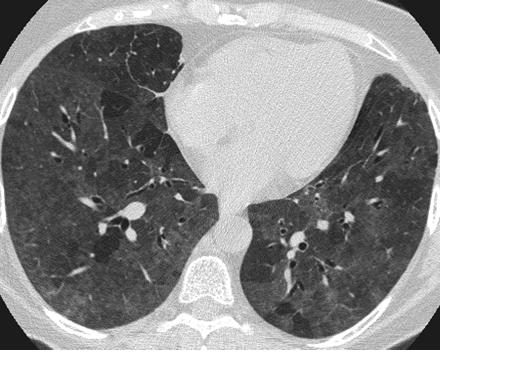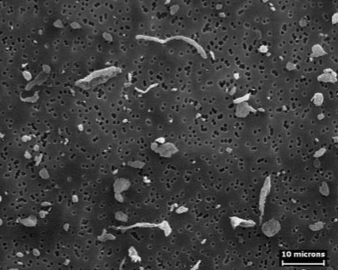Flock worker's lung on:
[Wikipedia]
[Google]
[Amazon]
Flock worker's lung is an
 Signs and symptoms of flock worker's lung include
Signs and symptoms of flock worker's lung include
 Flock worker's lung is caused by exposure to small pieces of flock, usually
Flock worker's lung is caused by exposure to small pieces of flock, usually
NIOSH Health Hazard Evaluation Report - Claremont Flock CorporationNIOSH Health Hazard Evaluation Report - Hallmark Cards, Inc.
Lung diseases due to external agents Occupational diseases Lung disorders
occupational lung disease
Occupational lung diseases are work-related, lung conditions that have been caused or made worse by the materials a person is exposed to within the workplace. It includes a broad group of diseases, including occupational asthma, industrial bronch ...
caused by exposure to flock, small fibers that are glued to a backing in order to create a specific texture. People who work in flocking are at risk of inhaling small pieces of the flock fibers, which causes interstitial lung disease
Interstitial lung disease (ILD), or diffuse parenchymal lung disease (DPLD), is a group of respiratory diseases affecting the interstitium (the tissue and space around the alveoli (air sacs)) of the lungs. It concerns alveolar epithelium, pul ...
. The disease was initially described in 1998, when a group of workers at a flocking plant developed interstitial lung disease of unknown cause.
Signs and symptoms
 Signs and symptoms of flock worker's lung include
Signs and symptoms of flock worker's lung include rales
Crackles are the clicking, rattling, or crackling noises that may be made by one or both lungs of a human with a respiratory disease during inhalation. They are usually heard only with a stethoscope ("on auscultation"). Pulmonary crackles are ...
(crackling noises caused by fluid in the lungs), dyspnea
Shortness of breath (SOB), also medically known as dyspnea (in AmE) or dyspnoea (in BrE), is an uncomfortable feeling of not being able to breathe well enough. The American Thoracic Society defines it as "a subjective experience of breathing disc ...
(shortness of breath), and coughing
A cough is a sudden expulsion of air through the large breathing passages that can help clear them of fluids, irritants, foreign particles and microbes. As a protective reflex, coughing can be repetitive with the cough reflex following three ph ...
. Abnormalities seen on a computed tomography (CT) scan of the lungs can include ground glass opacity and reticular opacity. The typical histopathology
Histopathology (compound of three Greek words: ''histos'' "tissue", πάθος ''pathos'' "suffering", and -λογία '' -logia'' "study of") refers to the microscopic examination of tissue in order to study the manifestations of disease. Sp ...
in flock worker's lung is bronchiolocentric interstitial pneumonitis and lymphocytic bronchiolitis with lymphocytic hyperplasia. Occasionally, desquamative interstitial pneumonia and bronchiolitis obliterans
Bronchiolitis obliterans (BO), also known as obliterative bronchiolitis, constrictive bronchiolitis and popcorn lung, is a disease that results in obstruction of the smallest airways of the lungs ( bronchioles) due to inflammation. Symptoms inclu ...
organizing pneumonia can be seen.
Other symptoms described in flock workers include pleuritic chest pain and atypical chest pain. Most cases described have been chronic and progressive. Lung function in individuals with flock worker's lung is generally diminished, with both restrictive and obstructive defects found.
Causes
 Flock worker's lung is caused by exposure to small pieces of flock, usually
Flock worker's lung is caused by exposure to small pieces of flock, usually nylon
Nylon is a generic designation for a family of synthetic polymers composed of polyamides ( repeating units linked by amide links).The polyamides may be aliphatic or semi-aromatic.
Nylon is a silk-like thermoplastic, generally made from pet ...
, created during the flocking process and inhaled. Exposure to rotary-cut flock particulates is the main risk factor; whether or not other types of flock cause this pulmonary fibrosis is not yet determined. Other types of flock include rayon
Rayon is a semi-synthetic fiber, made from natural sources of regenerated cellulose, such as wood and related agricultural products. It has the same molecular structure as cellulose. It is also called viscose. Many types and grades of viscose ...
, polypropylene
Polypropylene (PP), also known as polypropene, is a thermoplastic polymer used in a wide variety of applications. It is produced via chain-growth polymerization from the monomer propylene.
Polypropylene
belongs to the group of polyolefins an ...
, and polyethylene
Polyethylene or polythene (abbreviated PE; IUPAC name polyethene or poly(methylene)) is the most commonly produced plastic. It is a polymer, primarily used for packaging (plastic bags, plastic films, geomembranes and containers including ...
. Workers exposed to nylon, polypropylene, polyethylene, and rayon flocking debris have developed flock worker's lung. Exposure to higher concentrations of respirable flock particles is associated with more severe disease.
Whether or not smoking
Smoking is a practice in which a substance is burned and the resulting smoke is typically breathed in to be tasted and absorbed into the bloodstream. Most commonly, the substance used is the dried leaves of the tobacco plant, which have bee ...
affects the progression or incidence of flock worker's lung is a topic of ongoing research as of 2015. Research in rats has shown that nylon flocking is a causative agent.
Diagnosis
A CT scan of the lungs andhistopathology
Histopathology (compound of three Greek words: ''histos'' "tissue", πάθος ''pathos'' "suffering", and -λογία '' -logia'' "study of") refers to the microscopic examination of tissue in order to study the manifestations of disease. Sp ...
along with a history of working in the flocking industry can diagnose flock worker's lung. A differential diagnosis may also include Sjögren's syndrome and lymphoid interstitial pneumonia
Lymphocytic interstitial pneumonia (LIP) is a syndrome secondary to autoimmune and other lymphoproliferative disorders. Symptoms include fever, cough, and shortness of breath. Lymphocytic interstitial pneumonia applies to disorders associated w ...
. Flock worker's lung may be misdiagnosed as asthma
Asthma is a long-term inflammatory disease of the airways of the lungs. It is characterized by variable and recurring symptoms, reversible airflow obstruction, and easily triggered bronchospasms. Symptoms include episodes of wheezing, c ...
or recurrent pneumonia
Pneumonia is an inflammatory condition of the lung primarily affecting the small air sacs known as alveoli. Symptoms typically include some combination of productive or dry cough, chest pain, fever, and difficulty breathing. The severity of ...
. Though X-ray
X-rays (or rarely, ''X-radiation'') are a form of high-energy electromagnetic radiation. In many languages, it is referred to as Röntgen radiation, after the German scientist Wilhelm Conrad Röntgen, who discovered it in 1895 and named it ' ...
s may be abnormal, CT scans are more useful as a diagnostic tool in flock worker's lung. Other diagnostic methods may include a transbronchial biopsy or wedge biopsy
A biopsy is a medical test commonly performed by a surgeon, interventional radiologist, or an interventional cardiologist. The process involves extraction of sample cells or tissues for examination to determine the presence or extent of a d ...
.
Prevention
Flock worker's lung can be prevented withengineering controls
Engineering controls are strategies designed to protect workers from hazardous conditions by placing a barrier between the worker and the hazard or by removing a hazardous substance through air ventilation. Engineering controls involve a physi ...
that protect workers from inhaling flock. Engineering controls to prevent inhalation of flock can include using guillotine cutters rather than rotary cutters, and ensuring that blades are sharp, since dull blades shear off more respirable particles. NIOSH-certified respirators can be worn to reduce the risk of inhalation when performing certain activities. Flocking plants have also implemented medical surveillance programs for workers to diagnose cases at an earlier stage. Another technique for preventing flock worker's lung is cleaning the workplace with alternatives to compressed air in order to avoid resuspending particulates in the air.
Treatment
Flock worker's lung is generally treated by removing the individual from the environment where they are inhaling flock. Symptoms generally improve within days to weeks after stopping exposure. The benefits ofglucocorticoid
Glucocorticoids (or, less commonly, glucocorticosteroids) are a class of corticosteroids, which are a class of steroid hormones. Glucocorticoids are corticosteroids that bind to the glucocorticoid receptor that is present in almost every verte ...
therapy are unclear.
Prognosis
Flock worker's lung may raise the risk for lung cancer, but the connection is a topic of research as of 2015. The disease can be subacute or develop over long periods of exposure.Epidemiology
Cases have been reported in the United States, Canada, Turkey, and Spain.History
Interstitial lung disease in flock workers was first connected to flock fibers in 1991, though the disease now known as "flock worker's lung" was not formally described until 1998, when researchers fromNIOSH
The National Institute for Occupational Safety and Health (NIOSH, ) is the United States federal agency responsible for conducting research and making recommendations for the prevention of work-related injury and illness. NIOSH is part of the ...
published the results of an epidemiological investigation of outbreaks in Ontario
Ontario ( ; ) is one of the thirteen provinces and territories of Canada.Ontario is located in the geographic eastern half of Canada, but it has historically and politically been considered to be part of Central Canada. Located in Central C ...
and Rhode Island
Rhode Island (, like ''road'') is a state in the New England region of the Northeastern United States. It is the smallest U.S. state by area and the seventh-least populous, with slightly fewer than 1.1 million residents as of 2020, but i ...
. Previously, interstitial lung disease in flock workers was incorrectly attributed to mycotoxins
A mycotoxin (from the Greek μύκης , "fungus" and τοξίνη , "toxin") is a toxic secondary metabolite produced by organisms of kingdom Fungi and is capable of causing disease and death in both humans and other animals. The term 'mycotoxin' ...
present in contaminated adhesive. As of June 1999, 24 flock workers had been diagnosed.
References
External links
{{Medical resources , DiseasesDB = , ICD10 = {{ICD10, J, 67, , j, 60 , ICD9 = {{ICD9, 495 , ICDO = , OMIM = , MedlinePlus = , MeSH = , GeneReviewsNBK = , GeneReviewsName = , Orphanet =NIOSH Health Hazard Evaluation Report - Claremont Flock Corporation
Lung diseases due to external agents Occupational diseases Lung disorders